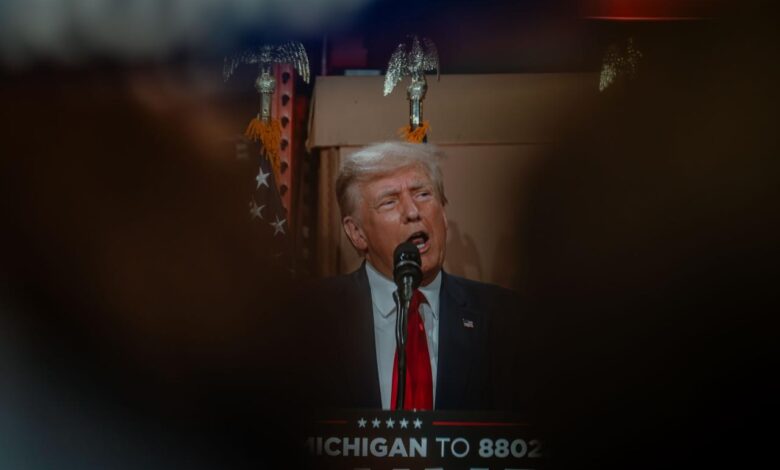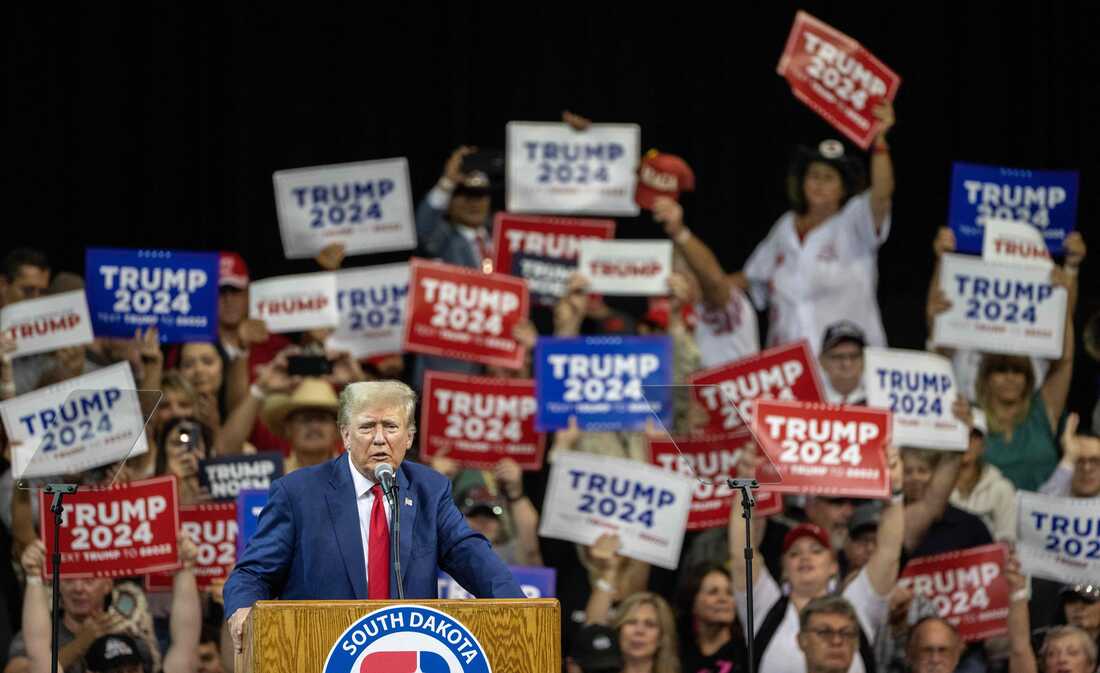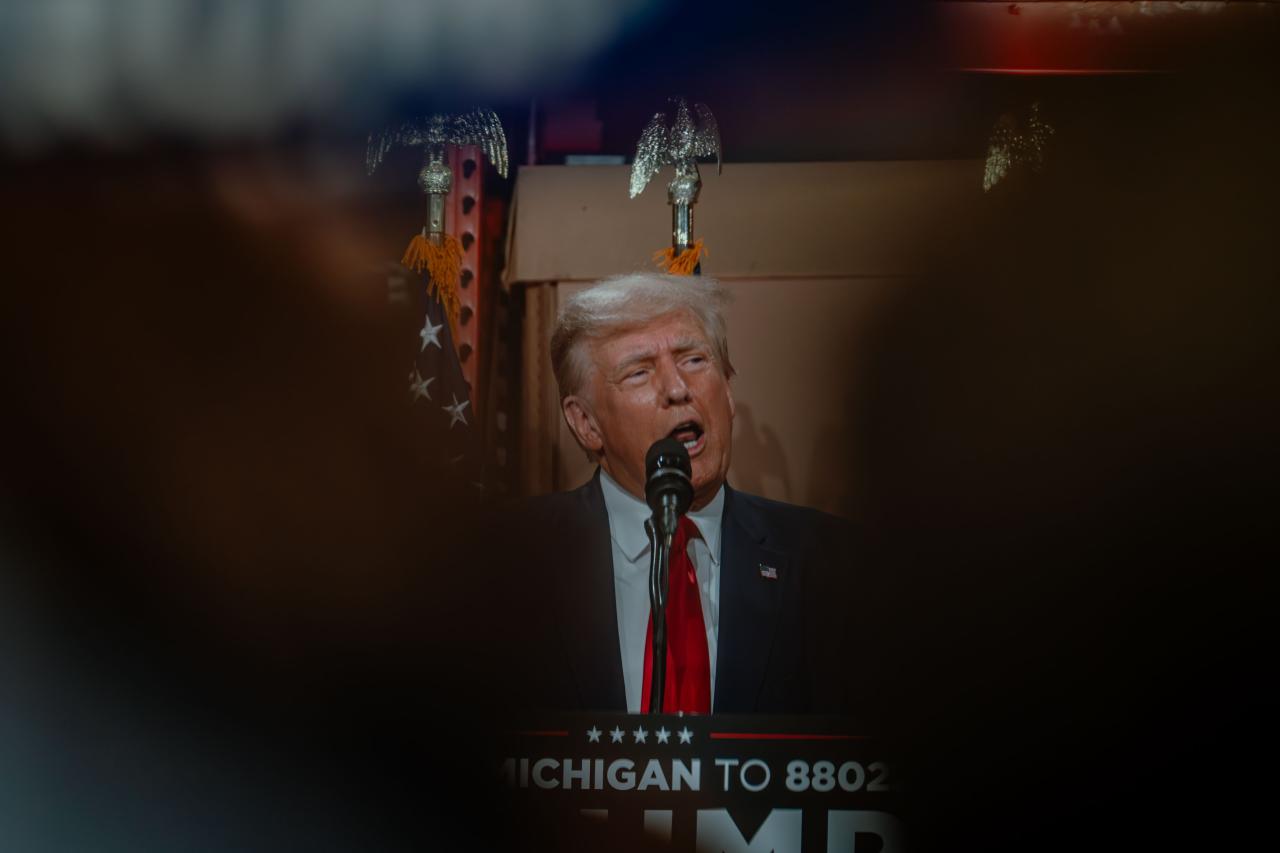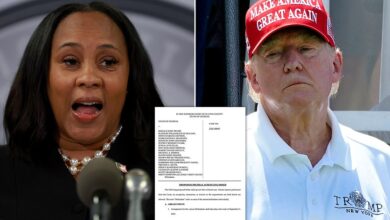
Trump 14th Amendment History A Look Back
Trump 14th Amendment history delves into the complex relationship between a controversial president and a foundational American amendment. The 14th Amendment, ratified after the Civil War, fundamentally redefined citizenship, due process, and equal protection under the law. How did these principles intersect with President Trump’s actions and statements? This exploration examines the historical context of the 14th Amendment, its core tenets, and its potential application to events during the Trump presidency.
We’ll trace the amendment’s origins, examining the societal pressures and key figures that shaped its creation. Then, we’ll unpack the crucial clauses regarding citizenship, due process, and equal protection, examining how the Supreme Court has interpreted them over time. Finally, we’ll analyze potential connections between Trump’s actions and the 14th Amendment, considering legal interpretations and potential modern applications.
Historical Context of the 14th Amendment

The 14th Amendment to the U.S. Constitution, ratified in 1868, stands as a pivotal moment in American history, fundamentally altering the relationship between the federal government and individual citizens. Its passage was a direct response to the aftermath of the Civil War and the tumultuous Reconstruction Era, aiming to address the lingering inequalities and injustices faced by newly freed slaves.
The amendment’s impact on civil rights and liberties continues to resonate today, shaping debates about citizenship, equality, and due process.The Civil War’s conclusion left a nation grappling with the question of how to integrate formerly enslaved people into society. Existing laws and social structures proved inadequate to the task, leading to widespread inequality and violence. The need for a constitutional amendment to secure basic rights for all citizens became increasingly apparent.
This imperative fueled the drive for the 14th Amendment, which aimed to grant citizenship and equal protection under the law to all persons born or naturalized in the United States.
Key Events Leading to the 14th Amendment
The passage of the 14th Amendment was inextricably linked to the Reconstruction Era, a period of significant social and political change following the Civil War. The Civil War had ended slavery, but its aftermath revealed the profound need for further action to ensure the rights of formerly enslaved people. The failure of previous attempts to address these issues, along with the persistent resistance to granting full citizenship and equal protection, underscored the urgent necessity for constitutional reform.
Reconstruction Era Policies and the 14th Amendment
Reconstruction Era policies aimed to rebuild the South and integrate formerly enslaved people into American society. These policies, however, faced considerable opposition from various segments of the population, including those who sought to maintain the pre-war social order. The 14th Amendment served as a critical component of Reconstruction efforts, aiming to enshrine the rights of all citizens in the Constitution.
The amendment’s provisions, particularly those related to citizenship and equal protection, directly addressed the issues of inequality that plagued the nation.
Timeline of Key Events
| Year | Event | Key Figures | Impact on Society |
|---|---|---|---|
| 1861-1865 | Civil War | Abraham Lincoln, Ulysses S. Grant, Jefferson Davis | The war ended slavery but highlighted deep-seated racial inequalities, necessitating further action. |
| 1865 | 13th Amendment Ratified | Various Congressional Representatives | Abolished slavery, but did not guarantee equal rights. |
| 1866 | Civil Rights Act of 1866 | Congress | Aimed to ensure equal rights for all citizens, including African Americans, but faced legal challenges. |
| 1868 | 14th Amendment Ratified | Various Congressional Representatives | Granted citizenship and equal protection under the law to all persons born or naturalized in the U.S., marking a significant step towards racial equality. |
Defining Citizenship Under the 14th Amendment

The 14th Amendment, ratified in 1868, fundamentally reshaped the understanding of citizenship in the United States. Its passage followed the Civil War and the abolition of slavery, creating a new legal framework for the newly freed African Americans and other marginalized groups. This amendment aimed to guarantee equal rights and protection under the law, a crucial step in the ongoing struggle for racial equality.The amendment’s definition of citizenship marked a significant departure from prior interpretations.
Pre-14th Amendment definitions of citizenship were often tied to state-level laws and often excluded significant portions of the population. The amendment’s provisions aimed to create a national standard of citizenship, ensuring that all persons born or naturalized in the United States were entitled to the same fundamental rights and protections.
Citizenship Clause Analysis
The 14th Amendment’s citizenship clause, Section 1, Clause 1, explicitly redefined citizenship. This clause lays the groundwork for subsequent interpretations and applications of the amendment’s principles.
“All persons born or naturalized in the United States, and subject to the jurisdiction thereof, are citizens of the United States and of the State wherein they reside.”
This concise yet impactful statement significantly altered the legal landscape. Previously, citizenship was often determined by state laws, leading to discrepancies and inconsistencies. The 14th Amendment established a uniform national standard, granting citizenship to all persons born within the country’s borders, barring certain exceptions.
Comparison of Pre- and Post-Amendment Citizenship
Before the 14th Amendment, citizenship was largely determined by state laws, often excluding African Americans and other marginalized groups. The Dred Scott v. Sandford Supreme Court decision (1857) famously denied citizenship to African Americans, arguing they were not part of the “political community.” This ruling highlighted the significant limitations of pre-amendment citizenship.After the 14th Amendment, the definition of citizenship became more inclusive, fundamentally altering the legal framework.
The amendment aimed to rectify the injustices of the past and create a more just and equitable society. It granted citizenship to individuals previously denied it, including African Americans, and fostered a more unified national identity. This shift in perspective was critical for the nation’s continued development and evolution.
Clauses Addressing Citizenship
The 14th Amendment contains several clauses that directly address the concept of citizenship. Understanding these clauses is essential for comprehending the amendment’s impact on American society.
| Clause | Explanation | Impact |
|---|---|---|
| Section 1, Clause 1 (Citizenship Clause) | Defines national citizenship based on birth or naturalization within U.S. jurisdiction. | Established a uniform national standard for citizenship, overruling prior state-based definitions and extending citizenship to groups previously excluded. |
| Section 1, Clause 2 (Due Process Clause) | Guarantees that no state shall deprive any person of life, liberty, or property without due process of law. | Provides a crucial protection against arbitrary state action, ensuring fair legal procedures. |
| Section 1, Clause 3 (Equal Protection Clause) | Guarantees that no state shall deny to any person within its jurisdiction the equal protection of the laws. | Prohibits discrimination based on race, ethnicity, or other factors, laying the groundwork for future civil rights legislation. |
The Relationship Between the 14th Amendment and Due Process
The 14th Amendment’s Due Process Clause is a cornerstone of American jurisprudence, ensuring fairness and fundamental rights for all citizens. It’s a crucial link between the federal government and the rights of individuals, establishing a crucial limit on state power. This clause, stemming from the 5th Amendment’s Due Process Clause, fundamentally protects individuals from arbitrary and unjust state action.The Due Process Clause has a dual nature, encompassing both procedural and substantive elements.
Procedural due process focuses on the fairness of the process by which the government deprives someone of life, liberty, or property. Substantive due process, on the other hand, delves into the fundamental rights protected by the clause, safeguarding them from government interference, regardless of the process used. Understanding how the Supreme Court has interpreted and applied these concepts over time is essential to appreciating the amendment’s impact.
Interpretation of the Due Process Clause
The Supreme Court has wrestled with defining the scope of the Due Process Clause over decades, evolving its interpretation in response to societal changes and legal challenges. Early interpretations focused primarily on procedural aspects, ensuring fair procedures in legal proceedings. Over time, the Court began to incorporate substantive elements, recognizing that certain rights were fundamental and deserving of protection from state encroachment, regardless of specific procedures followed.
Application of the Due Process Clause in Legal Cases
The 14th Amendment’s Due Process Clause has been applied across a wide spectrum of legal cases, shaping the contours of American constitutional law. This application is not static but has adapted to changing societal values and legal precedents.
Examples of Supreme Court Cases
The Supreme Court’s interpretation and application of the Due Process Clause are best illustrated through key Supreme Court cases. These rulings have established crucial precedents for subsequent legal challenges.
- Slaughter-House Cases (1873): This early case, while ultimately narrowing the application of the 14th Amendment to economic issues, laid the groundwork for later discussions about the scope of the Due Process Clause. The court narrowly defined the privileges and immunities clause, limiting the federal government’s role in protecting individuals from state abuses. This case, while not directly about substantive due process, impacted the early understanding of the 14th Amendment’s reach.
Digging into Trump’s 14th Amendment claims is fascinating, but the recent news about Chris Young’s charges being dropped ( chris young charges dropped ) raises some interesting questions about due process and the application of such laws. While the details surrounding the 14th Amendment’s history are complex, understanding these legal battles can help us better contextualize the broader political landscape and the role of the Constitution in modern society.
It’s a fascinating study in how historical context influences contemporary debates.
- Lochner v. New York (1905): This case exemplifies the Court’s early, and later criticized, application of substantive due process to economic regulations. The Court struck down a New York law limiting bakery workers’ hours, arguing it violated the right to contract freely. This ruling, heavily criticized later, represents an early attempt to incorporate economic rights under the umbrella of substantive due process.
- Griswold v. Connecticut (1965): This case, though not explicitly referencing the 14th Amendment, established the right to privacy as a fundamental right, which became increasingly important in later substantive due process cases. The Court recognized that certain rights, though not explicitly listed in the Constitution, were essential to liberty. This laid the foundation for future rulings on issues such as abortion and contraception, which used the Due Process Clause to protect these rights.
- Roe v. Wade (1973): A landmark case directly applying the 14th Amendment’s Due Process Clause, Roe v. Wade recognized a woman’s right to an abortion as a fundamental right, rooted in the right to privacy. The Court’s decision recognized the importance of a woman’s bodily autonomy as a significant element of substantive due process.
The Relationship Between the 14th Amendment and Equal Protection
The 14th Amendment, ratified in 1868, profoundly reshaped American jurisprudence. Central to its impact is the Equal Protection Clause, which mandates that no state shall deny to any person within its jurisdiction the equal protection of the laws. This clause, initially intended to safeguard the rights of newly freed slaves, has evolved to encompass a broader range of protections against discriminatory practices.The Equal Protection Clause isn’t a simple guarantee of identical treatment for all.
Instead, it necessitates that laws and government actions be rationally related to a legitimate government objective and that they not discriminate against particular groups or individuals. The Supreme Court, through its interpretations and rulings, has played a crucial role in defining the scope and application of this crucial clause.
Supreme Court Interpretations of Equal Protection
The Supreme Court’s interpretation of the Equal Protection Clause has been a dynamic process, shifting over time to reflect changing social norms and legal understanding. Early interpretations often involved narrow applications, but the Court’s understanding has progressively expanded to address a wider array of discriminatory practices. This evolution is evident in its approach to various legal cases, illustrating the Court’s ongoing effort to balance individual rights with the legitimate needs of the state.
Application of Equal Protection to Legal Cases, Trump 14th amendment history
The 14th Amendment’s Equal Protection Clause has been invoked in numerous landmark legal cases, each contributing to the evolving understanding of this fundamental principle. These cases, while diverse in their specifics, all grapple with the core question of whether government actions have discriminated against particular groups. The following table provides a glimpse into some key cases and their impact.
| Case Name | Key Issue | Court Ruling | Impact on Society |
|---|---|---|---|
| Plessy v. Ferguson (1896) | Legality of “separate but equal” facilities for racial segregation on public transportation. | Upheld state-sponsored segregation, establishing the “separate but equal” doctrine. | Perpetuated racial segregation and discrimination for decades, undermining the intent of the 14th Amendment. This ruling was later overturned by Brown v. Board of Education. |
| Brown v. Board of Education (1954) | Constitutionality of state-sponsored segregation in public schools. | Declared state laws establishing separate public schools for black and white students to be unconstitutional, citing the Equal Protection Clause. | A watershed moment in the Civil Rights Movement, dismantling the “separate but equal” doctrine and paving the way for desegregation in other areas of public life. |
| Loving v. Virginia (1967) | Constitutionality of anti-miscegenation laws prohibiting interracial marriage. | Ruled that state laws prohibiting interracial marriage violate the Equal Protection Clause of the 14th Amendment. | A significant victory for civil rights, invalidating discriminatory laws that targeted couples based on race. |
| Regents of the University of California v. Bakke (1978) | Constitutionality of affirmative action programs in university admissions. | Upheld the right of universities to consider race as one factor among many in admissions, but struck down the use of rigid quotas. | Established a complex legal framework for affirmative action, acknowledging the importance of diversity while prohibiting quotas. |
Trump’s Interactions with the 14th Amendment: Trump 14th Amendment History
The 14th Amendment, a cornerstone of American jurisprudence, guarantees citizenship rights and equal protection under the law. Its provisions, particularly concerning due process and equal protection, have been frequently invoked and interpreted throughout history. This section examines potential connections between President Trump’s actions and statements and the 14th Amendment, analyzing legal scholarship and applying the Amendment’s principles to specific events of his presidency.Analyzing President Trump’s interactions with the 14th Amendment requires careful consideration of his rhetoric and policy decisions, as well as the interpretations of legal scholars.
The 14th Amendment’s clauses offer a framework for evaluating whether certain actions or statements conform to constitutional principles.
Potential Connections to the Due Process Clause
The Due Process Clause of the 14th Amendment protects individuals from arbitrary government action. Potential applications to Trump’s presidency could be seen in his administration’s policies related to immigration, including the separation of families at the border. Legal scholars debated whether these policies violated the Due Process Clause by denying basic rights and creating undue hardship. Similarly, challenges to executive orders or actions impacting certain groups might have invoked due process considerations.
Trump’s interpretation of the 14th Amendment has been a hot topic, sparking debate about citizenship and rights. Interestingly, this debate about who is a citizen under the 14th Amendment might be relevant to how KKR’s private equity firm approaches employee ownership, as seen in kkr private equity employee ownership. Ultimately, the historical context of the 14th Amendment continues to shape our understanding of American citizenship.
Potential Connections to the Equal Protection Clause
The Equal Protection Clause of the 14th Amendment prohibits the government from denying equal protection of the laws to any person within its jurisdiction. Trump’s rhetoric and policies related to immigration, race, and other social issues could have been analyzed through the lens of this clause. For example, statements perceived as discriminatory toward particular groups or policies that disproportionately affected certain communities could be subject to scrutiny under the Equal Protection Clause.
Specific Events and Statements Related to the 14th Amendment
- 2017 Travel Ban Executive Order: This executive order, which temporarily barred citizens from several Muslim-majority countries from entering the United States, prompted significant legal challenges. Some argued that the order violated the Equal Protection Clause by discriminating against individuals based on their religion. Legal scholars debated whether the order met the necessary standards of due process, and whether the national security rationale was sufficient justification for the discriminatory treatment.
- 2018 Charlottesville Protest: The president’s response to the white supremacist rally in Charlottesville, Virginia, drew significant criticism. Legal scholars questioned whether his rhetoric and actions constituted incitement or support for discriminatory ideologies, potentially violating the principles of equal protection under the law. The response’s effect on civil rights and potential impact on due process were also examined by legal experts.
- 2020 Election Challenges: Following the 2020 presidential election, President Trump made numerous statements challenging the election results and alleging widespread voter fraud. These claims were widely disputed by election officials and legal experts. Analysis of these claims through the lens of the 14th Amendment’s role in safeguarding fair elections was undertaken by legal commentators.
Timeline of Significant Events and Statements
| Date | Event/Statement | Potential 14th Amendment Connection |
|---|---|---|
| January 2017 | Inauguration Day | Inaugural address and subsequent actions potentially impacting the rights of specific groups or individuals. |
| 2017 | Travel Ban Executive Order | Potential violation of Equal Protection Clause. |
| 2018 | Charlottesville Protest Response | Potential incitement of discrimination or violation of equal protection. |
| 2020 | Election Challenges | Potential interference with the fairness and integrity of elections, which may impact due process rights. |
Potential Interpretations of the 14th Amendment in a Modern Context
The Fourteenth Amendment, ratified in 1868, remains a cornerstone of American jurisprudence, shaping legal battles and societal discourse for over a century and a half. Its broad language, encompassing citizenship rights, due process, and equal protection, continues to be debated and reinterpreted in contemporary legal contexts. Understanding these potential interpretations is crucial to appreciating the ongoing relevance of this pivotal amendment in a rapidly evolving society.The amendment’s enduring impact is tied to its ability to adapt to changing social norms and evolving legal thought.
Modern interpretations seek to reconcile the amendment’s original intent with the realities of the 21st century, often grappling with complex issues like immigration, affirmative action, and LGBTQ+ rights. The amendment’s flexibility allows for nuanced and sometimes conflicting interpretations, underscoring its importance in ongoing legal discussions.
Interpretations in Modern Legal Cases
The Fourteenth Amendment’s provisions have been central to numerous landmark Supreme Court cases. Cases involving discrimination based on race, gender, or other protected characteristics frequently rely on the Equal Protection Clause. For example, the Supreme Court’s rulings on affirmative action programs directly address the application of equal protection in the context of educational opportunities. Likewise, cases concerning immigration rights often invoke the Due Process Clause to evaluate government actions affecting non-citizens.
The diverse interpretations reflect the evolving legal landscape and the ongoing debate about the amendment’s scope and application in contemporary society.
Societal Changes Impacting Application
Significant societal shifts have undeniably influenced the interpretation of the Fourteenth Amendment. The Civil Rights Movement, the feminist movement, and the LGBTQ+ rights movement, each brought about profound social and political changes that have necessitated re-evaluations of the amendment’s provisions. These movements have highlighted systemic inequalities and injustices, prompting legal scholars and judges to examine how the amendment can be applied to address contemporary forms of discrimination.
For instance, the increasing awareness of implicit bias and systemic discrimination in various sectors has spurred legal challenges based on the Equal Protection Clause, demanding more nuanced interpretations to ensure fairness and equality.
Different Legal Perspectives
Diverse perspectives exist on interpreting the Fourteenth Amendment. Some legal scholars emphasize the amendment’s original intent, arguing that its provisions should be interpreted consistently with the understanding of the time. Others adopt a more evolving perspective, arguing that the amendment’s principles must adapt to contemporary societal needs and values. The tension between these approaches often manifests in legal debates, highlighting the inherent complexity of applying historical principles to modern problems.
These contrasting interpretations often involve differing views on the scope of rights protected and the appropriate methods of achieving equality.
Digging into Trump’s 14th Amendment claims is fascinating, but it’s important to understand the broader political landscape. For example, understanding the intricacies of the upcoming Nevada caucus primary is crucial for interpreting the current political climate. A helpful resource to get up to speed on the Nevada caucus primary is this explainer: nevada caucus primary explainer.
Ultimately, the 14th Amendment’s historical context remains a key part of any meaningful discussion about Trump’s actions and statements.
Arguments for and Against Specific Interpretations
Arguments for specific interpretations of the Fourteenth Amendment often center on their ability to address contemporary injustices. For example, arguments supporting broad interpretations of equal protection often aim to combat discrimination based on various factors, including sexual orientation and gender identity. Conversely, arguments against expansive interpretations frequently emphasize concerns about the potential for government overreach or the disruption of established social norms.
These arguments are often nuanced and complex, with strong justifications from both sides, highlighting the ongoing debate about the precise meaning and application of the Fourteenth Amendment.
Illustrative Historical Examples
The Fourteenth Amendment, ratified in 1868, fundamentally reshaped American law and society. Understanding its impact requires examining how its principles were applied and challenged throughout history. This section will delve into specific historical examples, highlighting legal cases, social movements, and periods where the Amendment’s provisions played a crucial role.The Fourteenth Amendment’s provisions on citizenship, due process, and equal protection have been at the heart of countless legal battles and social transformations.
Examining these examples illuminates the enduring significance of this landmark amendment in shaping the American legal landscape and its ongoing relevance to contemporary issues.
Trump’s interpretation of the 14th Amendment has been a hot topic lately, sparking debate and discussion. It’s fascinating to consider how legal arguments connect to culinary prowess, like watching Gordon Ramsay masterfully whip up a dish in Gordon Ramsay next level chef. Ultimately, the historical context of the 14th Amendment remains a complex and important area of study.
Plessy v. Ferguson (1896)
This landmark Supreme Court case directly challenged the Fourteenth Amendment’s Equal Protection Clause. The case involved Homer Plessy, a mixed-race man, who refused to sit in a designated “colored” railway car. The Court upheld the constitutionality of state-sponsored segregation, establishing the “separate but equal” doctrine. This ruling significantly undermined the intended purpose of the Fourteenth Amendment, allowing for discriminatory practices under the guise of “separate but equal” facilities.
Trump’s interpretation of the 14th Amendment’s citizenship clause has been a hot topic, sparking debate. While the amendment’s history is rich and complex, it’s fascinating how discussions about legal precedents sometimes connect to seemingly unrelated topics, like the recent buzz around the “Godzilla Oppenheimer Heron Boy” godzilla oppenheimer heron boy phenomenon. Ultimately, the 14th Amendment’s historical context remains crucial to understanding its impact today.
The “separate but equal” doctrine was later deemed unconstitutional inBrown v. Board of Education*.
The Civil Rights Movement
The Civil Rights Movement of the mid-20th century directly engaged with the Fourteenth Amendment’s promise of equal protection. Activists challenged discriminatory practices in voting, housing, education, and public accommodations. Landmark legislation like the Civil Rights Act of 1964 and the Voting Rights Act of 1965 were significant achievements that built upon the principles of the Fourteenth Amendment. These movements sought to ensure that all citizens, regardless of race, were afforded equal protection under the law.
These struggles directly reflected the ongoing tension between the ideals enshrined in the Fourteenth Amendment and the reality of racial inequality in America.
Reconstruction Era (1865-1877)
The Reconstruction Era saw significant efforts to apply the Fourteenth Amendment to formerly enslaved people. Southern states, however, often resisted these efforts through discriminatory laws and violence. This period vividly illustrates the ongoing struggle to fully implement the Amendment’s guarantees of citizenship and equal protection, particularly in the face of entrenched racial prejudice and political resistance. Federal efforts to enforce the amendment were often met with resistance and violence.
The failure to fully implement the Fourteenth Amendment’s provisions during Reconstruction laid the groundwork for future challenges to racial equality.
Timeline of the 14th Amendment’s Application in the Reconstruction Era
| Year | Event | Impact on 14th Amendment |
|---|---|---|
| 1868 | Fourteenth Amendment ratified | Provided a legal basis for challenging state-sponsored discrimination. |
| 1870 | Fifteenth Amendment ratified | Granted voting rights to African American men, further supporting 14th Amendment principles. |
| 1873 | Supreme Court case: Slaughter-House Cases | Narrowed the scope of the Fourteenth Amendment’s application, limiting its protection for newly freed slaves. |
| 1877 | End of Reconstruction | Marked a significant retreat from federal enforcement of the Fourteenth Amendment, allowing racial discrimination to flourish in many Southern states. |
The table above Artikels key events during the Reconstruction Era, highlighting how the Fourteenth Amendment’s principles were both applied and challenged. This period demonstrates the tension between constitutional ideals and practical implementation, ultimately shaping the course of American race relations for generations to come.
Ultimate Conclusion
In conclusion, analyzing Trump’s interactions with the 14th Amendment highlights the enduring relevance of this crucial piece of legislation. While the amendment’s principles were debated throughout history, its potential applications during the Trump administration offer a fascinating case study of how constitutional principles intersect with contemporary political discourse. Ultimately, this exploration underscores the ongoing importance of the 14th Amendment in shaping our understanding of American citizenship and rights.
FAQ Section
What specific legal cases have directly applied the 14th Amendment’s due process clause during Trump’s presidency?
While no high-profile Supreme Court cases directly cited the 14th Amendment’s due process clause in relation to President Trump’s actions, legal scholars have discussed its potential application in various contexts.
Did any specific events during Trump’s presidency raise concerns about violations of the 14th Amendment’s equal protection clause?
Legal scholars have examined various events during Trump’s presidency through the lens of the 14th Amendment’s equal protection clause. Discussions have focused on issues such as immigration policies and executive orders, examining their potential impacts on different demographics and groups.
How has the 14th Amendment been interpreted in relation to immigration policies?
Interpretations of the 14th Amendment’s citizenship clause in relation to immigration policies have been complex and multifaceted. Legal scholars have explored various perspectives, considering historical precedents and contemporary societal contexts.






